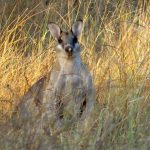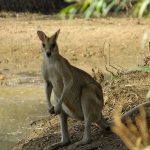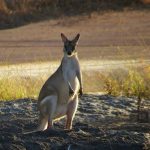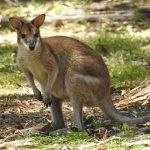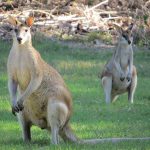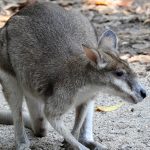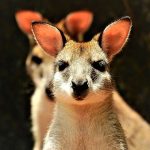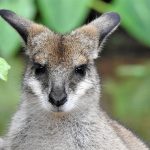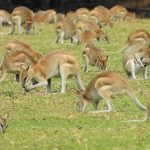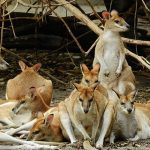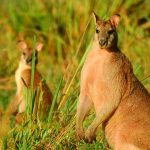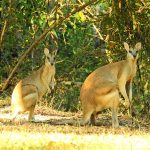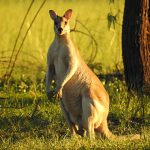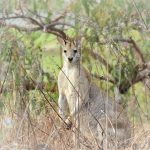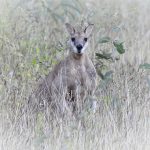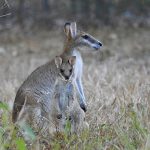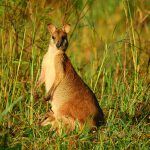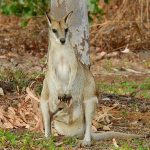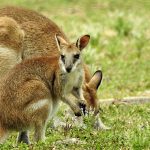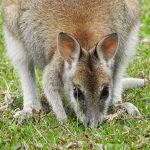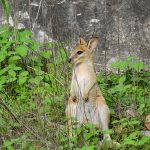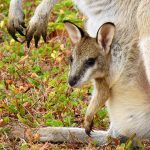AGILE WALLABY
The Allied Rock-wallaby: The Little Acrobat of the Cliffs
The Allied Rock-wallaby is one of Australia’s quiet specialists—small, shy, and superbly adapted to life among rocks and cliffs in the country’s north-east. Imagine a kangaroo shrunk down, made lighter on its feet, and set to live on steep rocky slopes instead of open plains: that is the world of the Allied Rock-wallaby.
Where They Live
The Allied Rock-wallaby is found mainly in north-eastern Queensland, especially:
- Along the Great Dividing Range in the north-east
- In rocky outcrops, escarpments, and boulder hills
- Around steep gullies and rugged hillsides
They are rock specialists. You will not find them hopping across wide grassy paddocks like Eastern Grey Kangaroos. Instead, they live where:
- There are large boulders, rock piles, and cliffs
- They can shelter in rock crevices and caves
- A mix of shrubs, grasses and small trees grows between the rocks
These rocky landscapes protect them from predators and harsh weather, and also give them many places to hide.
What They Look Like
Allied Rock-wallabies are small to medium-sized wallabies.
Size and Build
- Body length: about 50–65 cm
- Tail length: about 50–70 cm (often as long as, or longer than, the body)
- Weight: usually 3–7 kg
They have:
- Strong hind legs for jumping across rocks
- Long, thick tail used for balance, especially on steep, uneven ground
- Soft, padded feet that grip rock surfaces
Colours and Markings
Their fur is designed for camouflage:
- Overall colour: grey-brown to sandy-brown
- Lighter underparts: cream or pale grey on the belly
- Often a paler stripe on the side of the face or along the flank
- Tail may be darker towards the tip
Seen from a distance, they blend smoothly into the rocks and shadows, which helps them avoid being spotted by predators—and by people.
Masters of Rocky Acrobatics
If you watched an Allied Rock-wallaby in its natural habitat, you would see an expert climber and jumper.
They can:
- Leap from rock to rock with surprising precision
- Use their tail as a counterweight when turning or landing
- Race up steep slopes that would be hard for a human to walk
Their hind feet have textured pads that provide grip, almost like built-in climbing shoes. This allows them to move quickly across surfaces that would be slippery or dangerous for many other animals.
What They Eat
Allied Rock-wallabies are mainly herbivores, feeding on:
- Grasses
- Leaves
- Shrubs and herbs
- Sometimes fruits and seeds when available
Because they live in often dry, rocky environments, food and water can be limited. They cope by:
- Feeding mostly in the cooler hours of dusk, night, and dawn
- Getting much of their water from the plants they eat
- Being very efficient with moisture, so they do not need to drink often if food is good
They usually stay hidden among rocks during the hottest part of the day.
Behaviour and Social Life
Activity Patterns
Allied Rock-wallabies are mostly:
- Nocturnal and crepuscular (active at night and around sunrise and sunset)
- Resting in caves, deep cracks, or under overhangs during the day
Social Structure
They are usually found in small groups, sometimes called colonies, that share:
- The same rocky area
- Common shelter sites
- Overlapping feeding spots
Within these colonies:
- There may be a dominant male and several females
- Younger animals often move between nearby rock piles as they grow
They are generally quiet animals, relying more on body language and scent than loud calls, but they may make soft sounds, especially between mothers and young or when alarmed.
Reproduction and Life Cycle
Like other macropods (kangaroos and wallabies), Allied Rock-wallabies have a pouch and give birth to tiny, underdeveloped young called joeys.
Breeding
- Females can breed once a year, sometimes more often under good conditions
- A joey is born very small, furless, and blind, and crawls to the pouch after birth
Pouch Life
- The joey stays in the pouch for about 6–7 months
- It will then start to:
- Poke its head out
- Take short trips out of the pouch
- Return to the pouch for safety and feeding
Even after leaving the pouch completely, the young may continue to suckle from the mother for a while and stay close to her as it learns to navigate the rocky environment.
Predators and Threats
In the wild, natural predators include:
- Large birds of prey (e.g. eagles)
- Large pythons
However, their main threats today come from human-related changes:
Introduced predators
- Foxes and feral cats can hunt adults and especially young wallabies.
Habitat degradation
- Overgrazing by feral goats, cattle, or other stock can reduce the plants they feed on.
- Clearing vegetation near rocky areas can make them more exposed to predators.
Isolation of populations
- Rock-wallaby colonies are often separated by large distances of unsuitable habitat.
- This makes it harder for individuals to move between colonies, reducing genetic diversity over time.
Conservation Status
The Allied Rock-wallaby is not as severely threatened as some of its close relatives, but it is still of conservation concern in parts of its range.
Different rock-wallaby species across Australia vary from common to endangered, and many face similar problems:
- Fragmented habitats
- Introduced predators
- Competition for food with feral animals and livestock
Conservation efforts often include:
- Fox and feral cat control
- Goat control to reduce competition and habitat damage
- Protection of rocky refuges and surrounding vegetation
- Monitoring colonies to track population trends
Keeping their rocky homes intact is essential. Once those cliff and boulder habitats are disturbed or heavily grazed, rock-wallabies quickly lose the shelter and food they rely on.
Why They Matter
Allied Rock-wallabies are:
- A key part of rocky hill ecosystems, helping to shape the plant communities by what they eat and how they move seeds
- A living example of evolutionary adaptation, showing how animals can specialise to succeed in tough, steep environments
- A symbol of how small, quiet species can be easily overlooked but still be deeply vulnerable to change
Caring for them also means caring for the wider landscape: protecting rocky hills and surrounding bush supports many other species of plants, reptiles, birds, and invertebrates that share the same environment.
How You Can Connect With Them
Even if you do not live near their habitat, there are ways to engage:
- Visit wildlife parks or sanctuaries that keep rock-wallabies and support breeding or conservation programs.
- Support conservation groups working in north Queensland and across Australia to protect rock-wallaby habitats.
- Learn more about other Petrogale species—there is a whole group of rock-wallabies, each adapted to its own region and rock country.

